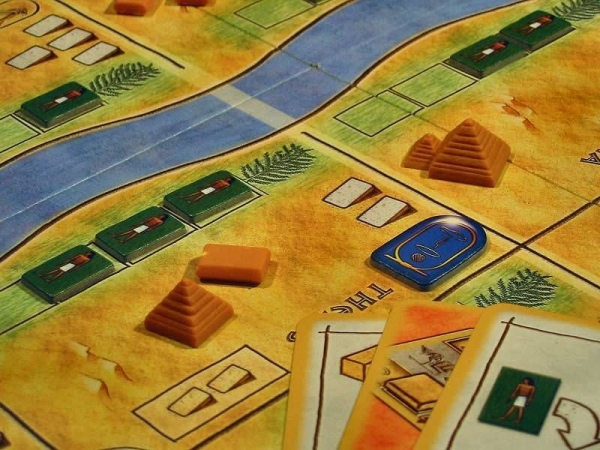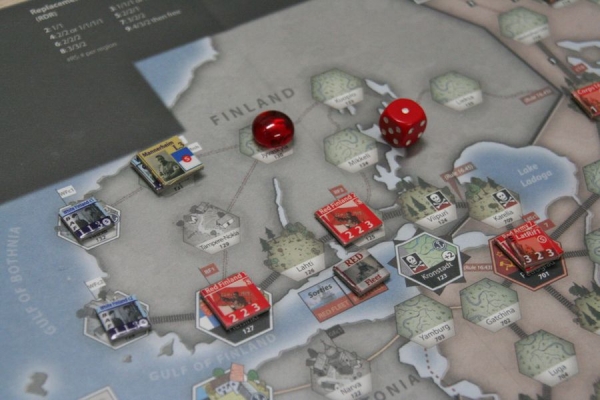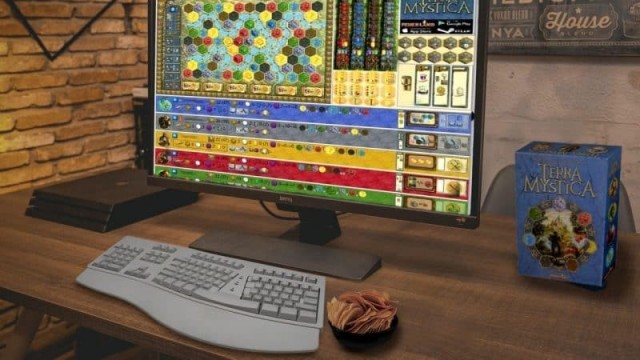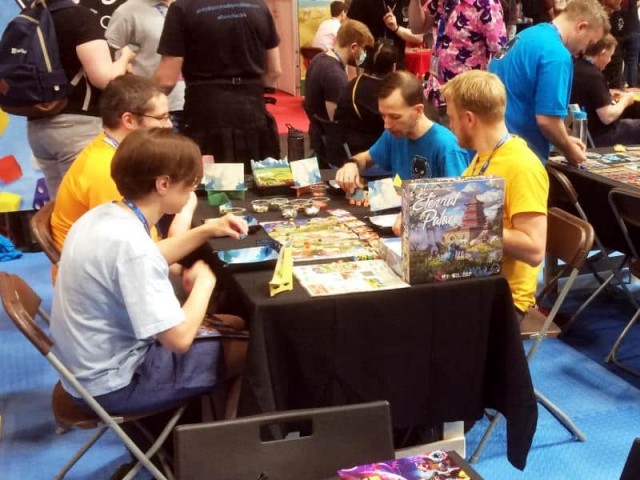What your collection may be saying about what you like, how you like it, and if it means anything
I have 132 games in my home that I'm actively seeking to play and about another dozen on the trade pile that may never see the light of day again unless it's from someone else opening the box. This doesn't include expansions and/or variations on the respective game, like Funkoverse's various sets. It's just games or game systems, as a whole. That's a mildly ridiculous number and something that makes me cringe from time to time, both because it's a significant accumulation of excess and because I realize that the time needed to extract actual value from all of these games is unlikely to be available anytime soon, if ever. I'm suggesting "actual value" here as the ability to play each of them multiple times. I have, in fact, played almost all of them more than once so one could say that I have extracted "actual value" from the majority of them and am still making progress on the rest. But the phrase "too much X, too little time" exists for a reason and it especially applies to board games in these Our Days of COVID, which makes it more difficult to get groups of any size together. But since I'd gone through the whole list the other day, I thought I might take a look at the state of the collection from a variety of perspectives: mechanics, style, theme, age, weight, and anything else that might occur. I don't know that this will generate any profound insights, but I suppose that's something for you, the reader, to assess.
As a technical note, when I've tallied up numbers, I have included a couple games from that trade pile based mostly on the number of plays I had with them. If they were in heavy rotation, they're included as part of the general overview. If not, not.

Right off the bat, the most frequent mechanic in my collection is area control (40) and the most frequent style is wargame (39.) Believe it or not, the two are not inherently tied together as it is possible to have a game that incorporates the mechanic, like Tigris & Euphrates, but doesn't generally fit the themes that are common to wargames. This is, of course, despite the fact that T&E does have conflict as part of its gameplay. This is how nebulous these terms will often be throughout this examination, but I'm going to try to avoid any tangents about whether X game is X type or style. Given the prevalence of those two aspects, it can't be overly surprising that another frequent style is Dudes on a Map (DoaM; 27.) Many of the games that I play most frequently and am often gathering people together to participate in are DoaMs (lately Ankh, Root, Cry Havoc, etc.), even if they're more abstracted versions of the concept, like Oath. However, neither Oath nor Ankh are among those I would list as wargames, whereas Root and Cry Havoc definitely are. Again, these definitions are really anything but and are more properly labeled "concepts" or even "estimations."
A good chunk of my wargames are what meet the standard definition: releases from companies like GMT or Columbia that are representations of historical conflicts. Those are the ones most often labeled as simulations (16), as well. They have rulesets that try to depict the various environmental factors that surrounded those conflicts, like the limits of the roads in Crusader Rex or the possibility of a royal marriage in Hammer of the Scots. Only three, though, meet the old "standard definition" (Britannia, Revolt on Antares, Warriors of Japan) of hex-and-counter, made most famous by Avalon Hill. However, 878 Vikings is a wargame that is a simulation, but which is considered a DoaM because of the miniatures provided, rather than cardboard counters or blocks with numbers on them. Can a block be a dude? Or is a dude just a fancier counter? After all, Battlelore 2nd Ed does use a hex map, even if it also uses miniatures. A lot of that type of game also occupies the 2-player segment of the collection (13) in that most block wargames or hex-and-counter games are supposed to be 1v1. 878 Vikings goes one step beyond and involves two teams of two, although you can, of course, play it just 1v1, as well. Many of those games still use cardboard counters, like Sword of Rome, even if it's not on a hexagonal grid but instead uses point-to-point movement. And then there's the game that is 2-player and does use a hexagonal grid, but most wouldn't identify as a wargame, per se: Neuroshima Hex. In fact, you could easily call it a DoaM, but with hexagons. NHex actually strikes me as more of a "combat" game, similar to Tiny Epic Tactics or Funkoverse, in that you're using dudes/counters with specific abilities to conduct a smaller scale fight than you'd find in most block/counter games with numbers attached. That's not, of course, to say that TET or Funkoverse don't use stats or numbers, because of course they do. It's just a different way of looking at it.

Another thing that those two games use and which is a huge presence in the collection is dice, with no less than 52 using them in some fashion and often as the key determining facet for combat, like in The Hellgame. Having been a long-time player (and painter) of Games Workshop's oeuvre, I'm no stranger to dice and am not averse to their "randomness" at all. The key to most dice-based games is in trying to ensure that said randomness does not make or break the fight that you're involved in. In other words, you try to hedge the odds in your favor, even when rolling the fate cubes/polyhedrons. Their inclusion is usually centered around combat; from the fistfuls in Cthulhu Wars to the much more restrained system in Root. But they can also be tied to the actions that people can even perform on their turn, like in War of the Ring, Teenage Mutant Ninja Turtles: Shadows of the Past, and Tiny Epic Galaxies. In the latter, they have absolutely nothing to do with combat, but are the central aspect of one of the most "Euro" games of the Tiny Epic line.
"Euro", of course, is another style label that has largely fallen by the wayside in the last decade. The central conflict on Boardgamegeek used to be between the "Euro" mechanism fans and the "Ameritrash" story fans, until everyone realized that they could enjoy both styles and that many of them crossed that supposed border wall quite nicely; Chaos in the Old World being a prime example of this. I don't have many games in my collection that I would still apply the Euro label to (10), but among them are several Reiner Knizia classics like Taj Mahal and Modern Art, as well as push your luck (4) games like Downfall of Pompeii and card-driven (25) games like 13 Days. They tend to be games that are more mechanically-inclined, but they're not limited by that, either. Knizia was dogged by accusations that his themes are "pasted on" for many years, but anyone who's actually played his games would realize that that's not the case. Tigris & Euphrates is an excellent depiction of ancient Sumerian city growth, but it's an abstraction of that culture development which creates a brilliant game. Likewise, Modern Art could easily be a representation of a contemporary art market and competing bidders. In fact, Modern Art, an auction game (8) is probably my favorite Knizia, even though I'm not good at auction games (I don't think I've ever won a game of Modern Art...) Euros are often derided for their lack of presentation which many interpret as a lack of story, but I've never had a game attract as much attention by passersby for both its cool volcano and what we were doing with the volcano (tossing opponent's pieces into it) than Downfall of Pompeii. Likewise, 13 Days does an excellent job of directly telling the actual story of the Cuban Missile Crisis.

When referencing auction games, a close cousin are bidding games (6) which can be auctions and are often labeled that way, but don't strike me in the same way that things like Amun-Re or Dune do. The combat mechanic of Rising Sun is a bidding process, not an auction. I'd also suggest that something like Cyclades (also a DoaM, just like Rising Sun, but more economically-oriented) is also a bidding process, rather than an auction. You are bidding against each other for a certain god, but no one is gaining sole benefits from that bid, as in an auction, and everyone winds up with something. However, when you bid for combat results in Rising Sun and win, the money involved does go to the losers of the fight. Definitional vacillations abound. Likewise, the combat sequence in games like Dune: Imperium and Dune is essentially a bidding process, since you're gambling how many troops you're willing to lose, as normally none of them will be coming back home. On the other hand, Dune's Treachery card auction is exactly that; winner take all for each card. Games like Dune and Rising Sun also incorporate negotiation, which isn't a huge number in my list (5), but often is among the favorites (those two and Cosmic Encounter, for example,) alongside lesser-played gems like New Angeles.
Citing card-driven games like 13 Days brings us back to many of the wargames on the shelf, like Hannibal: Rome vs Carthage and Paths of Glory. But you could also call Black Fleet, a pickup-and-deliver (PU&D; 7), a card-driven game, as it depends on movement cards to drive the action of every piece on the board, just like Twilight Struggle or Hellenes: Campaigns of the Peloponnesian War. In fact, card-driven games present some of the best choices between story and mechanics, as cards often serve as both action points (16) and events and can be used for either, depending on the route the player wants to take. One of the brilliant aspects of Twilight Struggle is the delicate balance it achieves between wanting to directly affect the board or affect the overall environment; wanting to spend a card for its significant impact now versus saving it for what could be an even larger impact later. What ramps that up even more is that the deck of those cards changes twice during the game, so it's more difficult to suss out the hand that your opponent is holding, as is occasionally feasible in block wargames that use the same system.

That system also involves hand management, which is another sizable presence in the collection (39.) In some cases, like Android: Infiltration, it's less of a factor, as you're mostly using tech cards at opportune moments, rather than running the game with them. In other cases, of course, it's a central element, as with deckbuilders like Blood Bowl: Team Manager and Tyrants of the Underdark. How you properly execute a strategy with a constantly refreshing and changing resource is one of the roots of modern board game design, most notably in the case of Cosmic Encounter. Tyrants also incorporates another significant mechanic (area control), which is perhaps why it's a lasting favorite of mine. Hand management also applies to focused area control games like Battle for Rokugan, in which your "hand" is a collection of counters that are going on the map to accomplish your goals. How you distribute (manage) them is crucial. It's also present in, of course, straight card games like Blue Moon, where understanding both your faction's hand of cards and abilities and what remains in your deck and the opponent's potential plays is no less important than knowing the odds in heads-up play in poker. This is just as important in the case of cooperative games (5) like The Crew: The Quest for Planet Nine, where communication is restricted and interpreting what the other players will do in the context of what you're holding is essential. Likewise, it's just as important in card combat games like Ankh, where everyone knows what's in your hand based on what's sitting on the table or not.
Speaking of poker, I haven't included most of the classic abstracts (8) that people are familiar with, like chess, because although I have copies of most of the majors, I don't play them very often. The few exceptions that are in the list are those that I've played many times, like Go and mahjong, or those that I've played regularly in recent times, like Hnefatafl and Ur. Abstracts, of course, aren't always "classic", either, with games like Confusion: Espionage & Deception in the Cold War and Azul filling that category nicely. Those are the most frequent titles when it comes to grid movement (11), as well, but which is also filled by things like Monolith Arena (and Neuroshima Hex), Tiny Epic Mechs, and War Chest. "Classic" usually means "ancient" and there is something to be said for the age of the games in one's collection. While I've largely traded or sold many of my older games, such that the overwhelming majority come from the 21st century, or at least the 1990s, there are a handful of non-classics,that come from earlier times, like Britannia, Revolt on Antares, and Supremacy. That also presumes that one doesn't include reprints of modern classics like CE, Wiz-War, and Space Hulk.

There's also a distinct strain of the fantastic, with 41 having fantasy themes (Arcane Academy, Conan, Spirit Island), 33 having science fiction themes (51st State, Chimera Station, Cosmic Frog), and just 4 drawing something from the horror sphere (Fury of Dracula, Lovecraft Letter, The Others), with much crossover in between (The Others, for example, is easily labeled SF, as well.) There's also an obvious historical bent, with 16 rooted in modern history (Angola, Gandhi, Triumph of Chaos), 19 in medieval history (Inis, Guildhall, Richard III), and 14 in ancient history (Amun-Re, Kemet, Time of Crisis.)
Conclusions(?)
I think it's easy to imagine that I'm still more of an "Ameritrash" than a "Euro" fan, for whatever value those labels still possess. I definitely prefer games with direct interaction (a number of the aforementioned have the poorly-defined "Take that!" aspect on BGG) and am not a fan of co-ops. Despite my political history, I'm also drawn to things with direct conflict. As I used to say when I was running our state Green Party: "When I'm not out demonstrating for world peace, I play a lotta wargames." I also trend toward more complex games, although I haven't examined the "weight" assigned to them on BGG and I am still extremely fond of things like Guildhall, which are quite straightforward in rules complexity, but have depth in gameplay. I definitely favor multiplayer games over 2-players but, again, some of my all-time favorites are 1v1, like Battlelore 2nd Ed, Columbia's block games, and Blue Moon.
So are there any real conclusions to be drawn? I don't know. I know what I like and what I like is still pretty diverse, even if there are obvious trends (only 9 worker placement, but a couple of my favorites, like Tiny Epic Western.) What I'm hoping is that this has been an interesting tour of some of the ways we can interpret just what these games are and how they appeal to us. I will, of course, be fascinated to see some of the feedback in the forum of others' own piles of cardboard.
 Games
Games How to resolve AdBlock issue?
How to resolve AdBlock issue? 

















